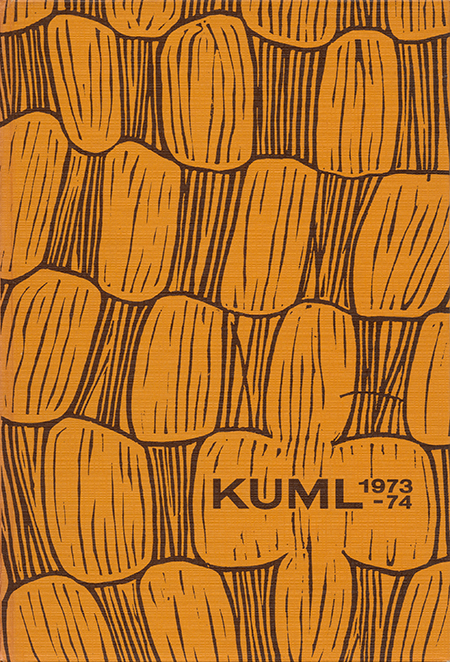Befolkning og social variation i ældre bronzealders Danmark
DOI:
https://doi.org/10.7146/kuml.v23i23.97023Nøgleord:
befolkning, bronzealderResumé
Population and social variation in Early Bronze Age Denmark
The last decade has witnessed a growing interest in population problems. For instance, a controversy has arisen - even in archaeology (2) - over Boserup's (1) anti-Malthusian theories. The archaeologist faces great difficulties when entering into such discussion. He usually deduces population sizes and densities from later, historical sources, and thus precludes inquiry into regional, and especially periodical differences. A set of simple, quantitative methods has, however, in the present case yielded information on relative population sizes and densities, and this knowledge is used along with other data to describe the societal regulations of the Early Bronze Age in Denmark (3).
The regional settlement pattern is reflected in the distribution of the graves, whose scatter at the same time informs us of changing population sizes and densities (Figs. 1-2). As a test of the validity of the methods used, information from pre-industrial Denmark of the second millennium AD. is employed (Fig. 5) (4). A fine balance is noted between the agricultural potential of the different zones (cf. Fig. 3) and population size. One zone/period (Zone 4, Period III, cf. Fig. 2), however, departs from the regression curve, having too high a population (Fig. 4). As the technological level in the zones is presumed to have remained the same throughout the era in question, a change of social structure, in other words in i.a. the organization of production, is suggested.
The distribution of wealth in the graves is quantified (5). It generally forms a triangular pattern with more poor than rich graves; this applies to both sexes, though the male graves are richer than the female ones (Fig. 6). Only in Zone 4, Period III do the male graves - and only they - display a very different pattern, with more rich than poor graves (Fig. 7). It can be shown that burial wealth is related to the social standing of the deceased, and we are tempted to interpret the Fig. 7 distribution as reflecting a more authoritarian society, where commands and demands have been strengthened to augment production. It is furthermore clear that the people in the graves (placed in burial mounds) belong to the higher social echelons of society. The number of female graves is normally only half the male number, which i.a. shows that the differences between "high" and "low" have not been too marked with respect to the women: Half the female relatives of the men from the mounds - and almost all the children - were never given such burial. In the more stratified society of Zone 4, Period III, the settlement pattern too takes on a different character with the advent of permanent "centres" (Fig. 2). In the foregoing period, Zone 4 has a relatively authoritarian distribution of male status, and changes in social structure may, in this case, have preceded population growth. This observation has some dialectic value at a time when a number of archaeologists have become attached to the Boserup idea of population increase and decrease as the independent variable in economic and social development.
Carrying this line of research even further, we note from a new diagram that there exists a strong positive correlation between population density and the status of high-ranking females, whose number (as opposed to that of the men) goes up with the density (Fig. 8). The male degree of social stratification also increases with a denser society. More important is it that the male-female degree of social stratification is positively correlated with population density (Fig. 9). In other words, not only the number, but also the division of rank of the high-status women is regulated according to male status, or vice versa. The status of these women is one of interchangeability with the high-ranking men, rather than of mere dependence on them. In the case of Zone 4, Period III, only the male degree of social stratification shows an extrasystemic rise. The high-status females fill, so to say, the gap in rank between the men and the rest of the population. (The division of the observations in Fig. 9 is due to an investment of metal artefacts in votive finds and hoards in Zones 1-3 (the eastern zones) competing with grave deposition).
We have, in sum, revealed how regularly - or systematically - the cultural variables change. The traditional archaeological explanations of cultural differences in terms of "fashion" and "impacts" cannot cope with the present observations. We have also demonstrated the utility of population data when describing not only the structure of production, but also the social organization of the society in question. What in some connection might be called the "evolutionary changes" of Zone 4 are regulated by the cultural system. Human populations change their culture to adapt to new conditions of life, they do not die. But this leaves the archaeologist, once more, with the problem of measuring "progress" on a comparative scale.
Klavs Randsborg
Downloads
Publiceret
Citation/Eksport
Nummer
Sektion
Licens
Fra og med årgang 2022 er artikler udgivet i Kuml med en licens fra Creative Commons (CC BY-NC-SA 4.0).
Alle tidligere årgange af tidsskriftet er ikke udgivet med en licens fra Creative Commons.


